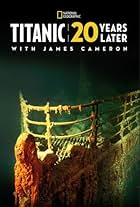An underwater expedition to the German battleship Bismarck and digitally reconstructs events that led up to the ship's sinking during World War II.An underwater expedition to the German battleship Bismarck and digitally reconstructs events that led up to the ship's sinking during World War II.An underwater expedition to the German battleship Bismarck and digitally reconstructs events that led up to the ship's sinking during World War II.
- Won 1 Primetime Emmy
- 1 win & 5 nominations total
Photos
Lance Henriksen
- Narrator
- (voice)
Holger Herwig
- Self - Bismarck Historian
- (as Dr. Holger Herwig)
Adrian Paul DeGroot
- Self - ROV Technician
- (as Adrian Degroot)
David Bercuson
- Self - Bismarck Historian
- (as Dr. David Bercuson)
Genya Chernaiev
- Self - MIR 2 Pilot
- (as Genya Cherniaev)
Curt Lowens
- Walter Weintz
- (voice)
Richard Doyle
- Karl Kuhn
- (voice)
Dean James
- Young Karl Kuhn
- (as Dean Jones)
Chris Shafer
- Young Heinz Steeg
- (as Christopher Shafer)
Storyline
Did you know
- TriviaThe recreations of the Bismarck were filmed aboard the USS North Carolina, a decommissioned World War II battleship. The ship now serves as a museum in Wilmington, North Carolina.
- ConnectionsReferenced in Aliens of the Deep (2005)
Featured review
As I watched this broadcast, I was surprised to see certain representations of damage and their explanations. I was also quite surprised that there was not adequate 'expert' witness present during the commentary. I am not a naval expert, but I do study these things, and consider wreck sites with a physics perspective. If I could come to an understanding of certain basic items, I expect that the on-site experts could as well. That the commentary shows otherwise leaves me questioning just who was where with what knowledge.
A few points as examples: The tower, with the admiral's bridge, foretop director station, etc.. JC suggests in the film that the tower landed on the bottom upright, and was pushed over as the hull moved against it after impact. His graphics even show this. I can not accept that explanation. Considering that the entire tower broke away as the ship sank, most likely during the righting of the hull after leaving the surface, and that the tower at that time was extremely TOP-heavy, it's quite apparent that it plummeted to the bottom much like an arrow. The very heavy armored foretop station (a thick box of armor plate dominating the upper levels of the tower) would have lead the way down (tower upside down), with the relatively long body section acting as the arrow's shaft. It would have plunged into the bottom sediment top-first. The hull did not knock it over from an upright position.
When JC's crew came across a hull section of the bilge broken away, they puzzled over just what it could be. It was obvious to myself and others that red antifouling paint, and a sharp near-90-degree bend in such a below waterline structure could only be the turn of the bilge. The uniform shape of the plating on either side of the turn, extending in both directions marks this wreckage even further as being the bilge turn near the center of the ship. No other shape could fit that area. To their credit, later in the documentary, they described this. What stood out to me was that no expedition member readily recognized this at the time of discovery.
The views of the stern underside show a rudder jammed into a propeller. JC stated that the torpedo hit must have jammed the rudder over to this point. This can't be. The propeller, in that shot, was truly fouled. However, the survivor's testimony states that efforts were made at steering the ship with engines only. There was no mention of a jammed shaft. Ballard's initial study, matched with eyewitness records show that Bismarck sank by the stern. This is because the ship's sea intakes and engine room water passages were blown open. The rear of the ship settled first from the flooding. As the ship dove to the bottom, it likely went down stern first as well, since the flooding in this area was more complete. Bismarck's stern quite well could have hit bottom first, jamming the rudders hard over. The rudder could not have been pushed so hard as to bend the rudder shaft so far that it hit the propeller from a mere torpedo hit. The weight of the ship, through an angular impact would certainly be able to accomplish this, however.
JC also states that the hull bent as it hit the bottom, like a shoe as the owner moves through a step. He says that this is what caused the bottom sides to blow out, assisted by hydraulic blowout. I can't see how this would be. His graphic representation is quite extreme. In order for the ship to bend as he shows, the very structure of the bottom would have to fail. You simply can not expect a warship to bend like that an not, a) compress the upper decks accordion style, and b) stretch the lower decks and double bottom to the point where they split. Bismarck sits intact (largely) and inline. No indications of hull warpage have been reported. Lastly, in order for this ship to bend like the banana move in the computer recreation, a large number of the huge armor plates on either side would have to be dislocated and /or removed. There is no way to bend 12' armor plate of that type against its plane! Warping it through the surface for hull fitting is one thing. Bending it along the thin edge several meters thick is impossible! You can watch and see that there are NO loose armor plates (only lower hull plates BELOW the armor line), and not even an open seem between the plates. The plates themselves could not be expected to work back into position and not leave evidence of having moved. Also, the inner torpedo bulkheads, which were so obligingly exposed, would have to bend as well (along with every other vertical longitudinal structure amidships). They did not. And if they had, they would never return to form since they were designed to flex and bend under stress in order to contain the torpedo blast, the following waterhammer jet, and still keep the citadel dry. The hydraulic blowout theory seems best, especially when you consider that German welding of the period was not the best. Reference the clean break in the tower base, the stern separation and the clean breaks at every point where lower hull sections are missing. Each break is at a weld joint.
Of all the points raised and issues taken during this film, I was most pleased with the study of the inner torpedo defense. It has been my contention that the torpedos were NOT the cause of her sinking. The large hole in the deck, next to the catapult, seems to me to be a torpedo hit, as the ship was rolling onto her side. The torps arrived too late.
The saving grace of this film is the quality of the video. One can draw his own conclusions from the clear images presented therein.
A few points as examples: The tower, with the admiral's bridge, foretop director station, etc.. JC suggests in the film that the tower landed on the bottom upright, and was pushed over as the hull moved against it after impact. His graphics even show this. I can not accept that explanation. Considering that the entire tower broke away as the ship sank, most likely during the righting of the hull after leaving the surface, and that the tower at that time was extremely TOP-heavy, it's quite apparent that it plummeted to the bottom much like an arrow. The very heavy armored foretop station (a thick box of armor plate dominating the upper levels of the tower) would have lead the way down (tower upside down), with the relatively long body section acting as the arrow's shaft. It would have plunged into the bottom sediment top-first. The hull did not knock it over from an upright position.
When JC's crew came across a hull section of the bilge broken away, they puzzled over just what it could be. It was obvious to myself and others that red antifouling paint, and a sharp near-90-degree bend in such a below waterline structure could only be the turn of the bilge. The uniform shape of the plating on either side of the turn, extending in both directions marks this wreckage even further as being the bilge turn near the center of the ship. No other shape could fit that area. To their credit, later in the documentary, they described this. What stood out to me was that no expedition member readily recognized this at the time of discovery.
The views of the stern underside show a rudder jammed into a propeller. JC stated that the torpedo hit must have jammed the rudder over to this point. This can't be. The propeller, in that shot, was truly fouled. However, the survivor's testimony states that efforts were made at steering the ship with engines only. There was no mention of a jammed shaft. Ballard's initial study, matched with eyewitness records show that Bismarck sank by the stern. This is because the ship's sea intakes and engine room water passages were blown open. The rear of the ship settled first from the flooding. As the ship dove to the bottom, it likely went down stern first as well, since the flooding in this area was more complete. Bismarck's stern quite well could have hit bottom first, jamming the rudders hard over. The rudder could not have been pushed so hard as to bend the rudder shaft so far that it hit the propeller from a mere torpedo hit. The weight of the ship, through an angular impact would certainly be able to accomplish this, however.
JC also states that the hull bent as it hit the bottom, like a shoe as the owner moves through a step. He says that this is what caused the bottom sides to blow out, assisted by hydraulic blowout. I can't see how this would be. His graphic representation is quite extreme. In order for the ship to bend as he shows, the very structure of the bottom would have to fail. You simply can not expect a warship to bend like that an not, a) compress the upper decks accordion style, and b) stretch the lower decks and double bottom to the point where they split. Bismarck sits intact (largely) and inline. No indications of hull warpage have been reported. Lastly, in order for this ship to bend like the banana move in the computer recreation, a large number of the huge armor plates on either side would have to be dislocated and /or removed. There is no way to bend 12' armor plate of that type against its plane! Warping it through the surface for hull fitting is one thing. Bending it along the thin edge several meters thick is impossible! You can watch and see that there are NO loose armor plates (only lower hull plates BELOW the armor line), and not even an open seem between the plates. The plates themselves could not be expected to work back into position and not leave evidence of having moved. Also, the inner torpedo bulkheads, which were so obligingly exposed, would have to bend as well (along with every other vertical longitudinal structure amidships). They did not. And if they had, they would never return to form since they were designed to flex and bend under stress in order to contain the torpedo blast, the following waterhammer jet, and still keep the citadel dry. The hydraulic blowout theory seems best, especially when you consider that German welding of the period was not the best. Reference the clean break in the tower base, the stern separation and the clean breaks at every point where lower hull sections are missing. Each break is at a weld joint.
Of all the points raised and issues taken during this film, I was most pleased with the study of the inner torpedo defense. It has been my contention that the torpedos were NOT the cause of her sinking. The large hole in the deck, next to the catapult, seems to me to be a torpedo hit, as the ship was rolling onto her side. The torps arrived too late.
The saving grace of this film is the quality of the video. One can draw his own conclusions from the clear images presented therein.
Details
- Release date
- Country of origin
- Official site
- Languages
- Also known as
- James Cameron's Expedition: Bismarck
- Filming locations
- Production companies
- See more company credits at IMDbPro
- Runtime1 hour 32 minutes
- Color
- Aspect ratio
- 1.78 : 1
Contribute to this page
Suggest an edit or add missing content
















